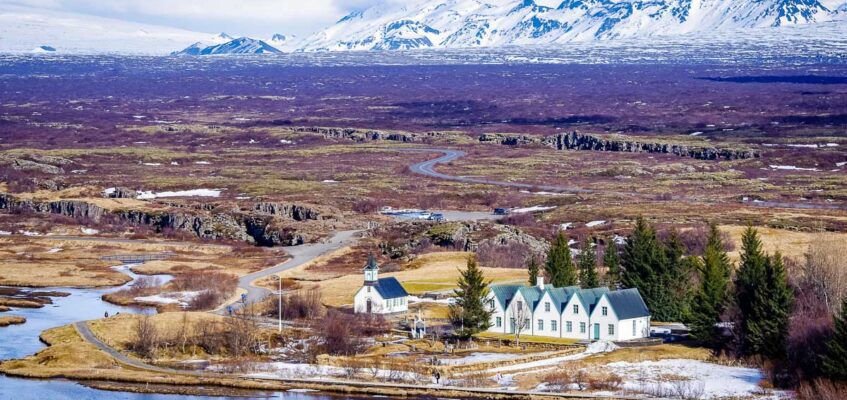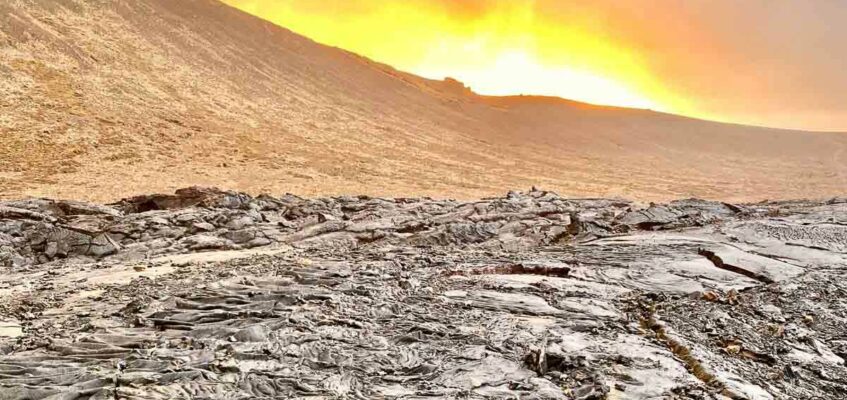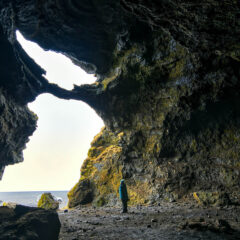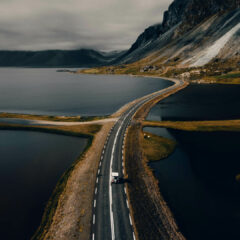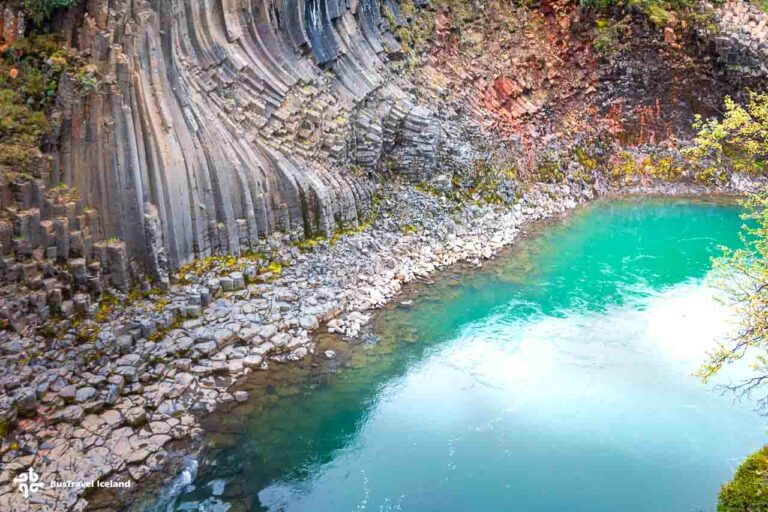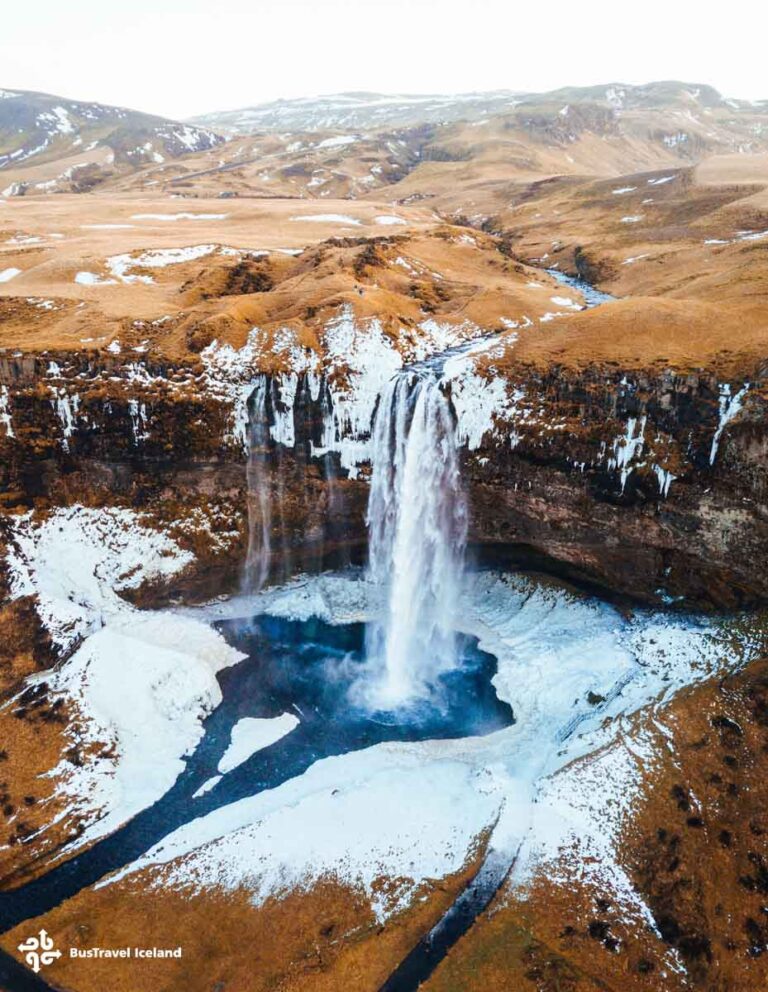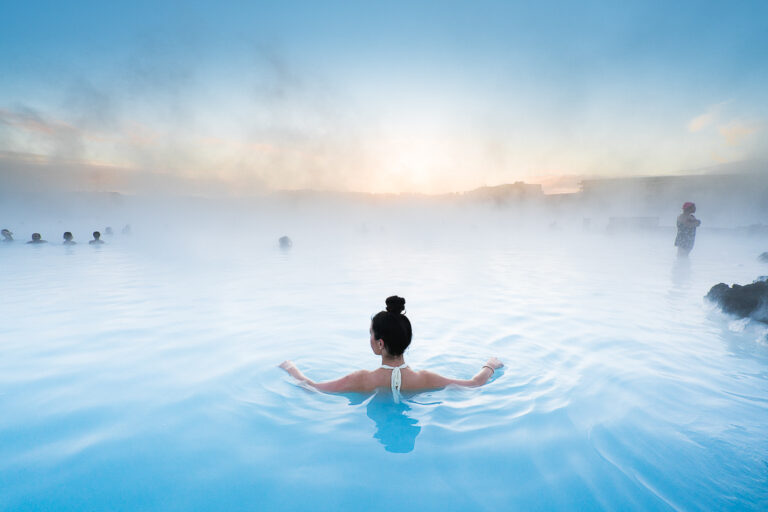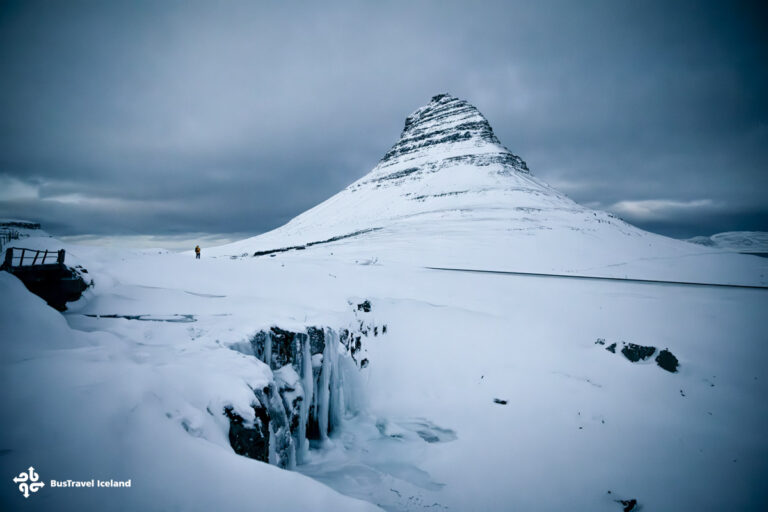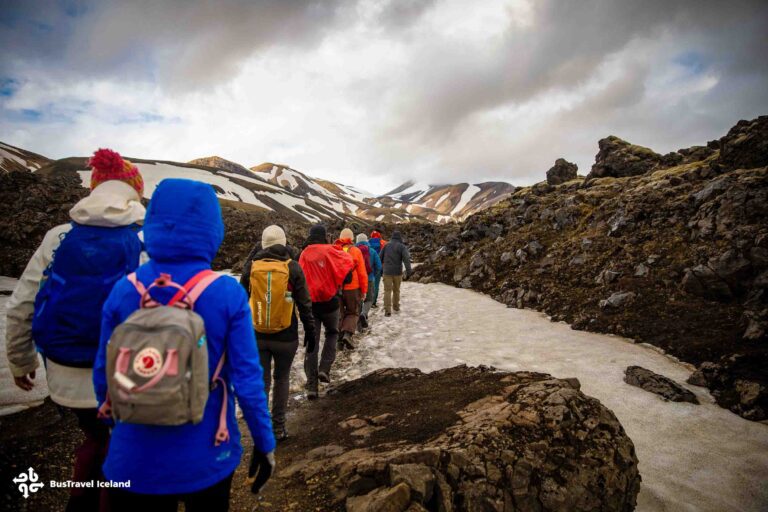Studlagil Canyon, Iceland’s Hidden Gem of Basalt Columns
- East Iceland
- 10 Mar 2025
Visiting Stuðlagil Canyon, East Iceland’s hidden gem, with stunning basalt columns and a vibrant blue glacial river. A must-visit for adventurers and photographers!
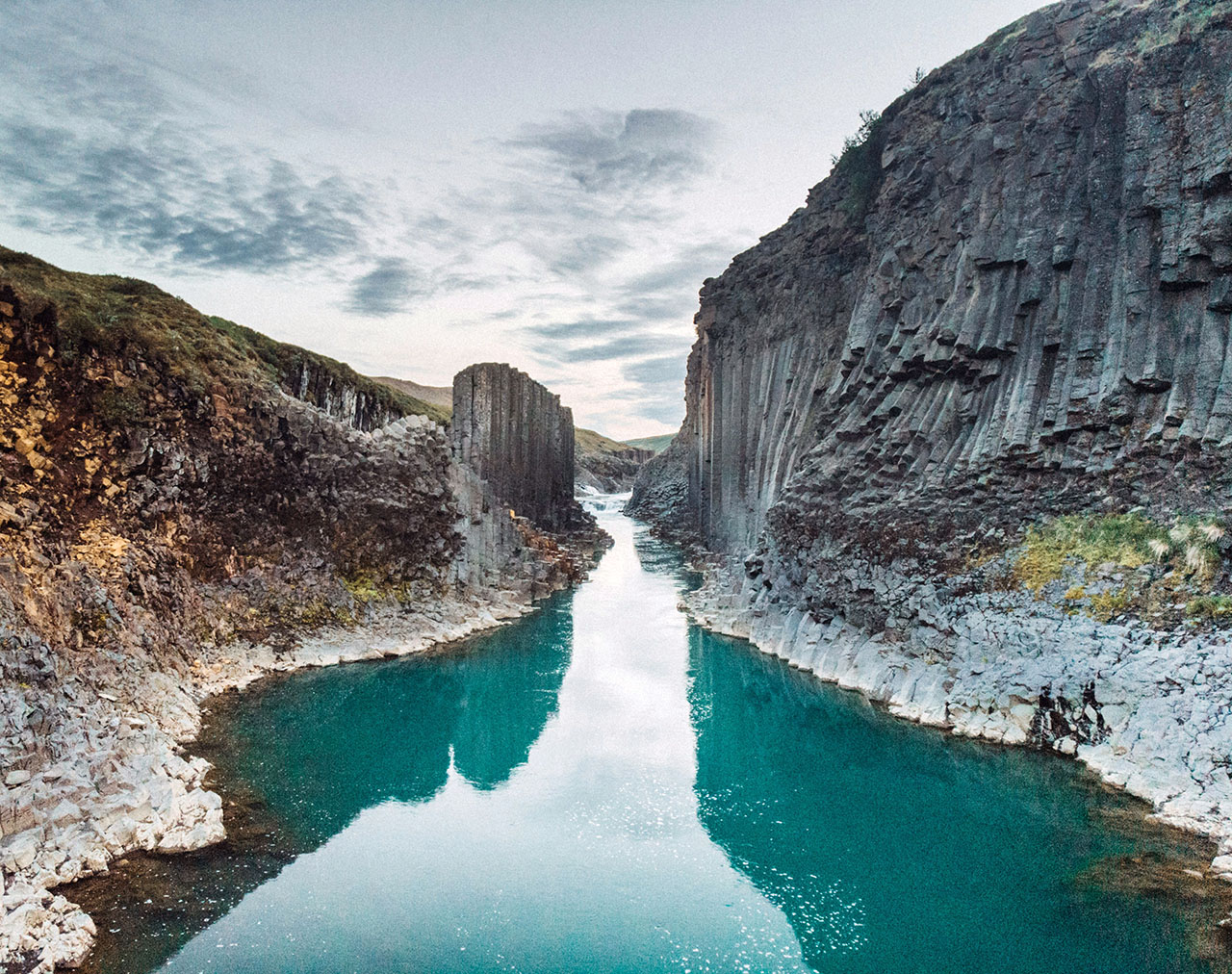
Hidden deep in the remote Jokuldalur Valley of East Iceland, Studlagil Canyon is a breathtaking natural wonder that has remained largely undiscovered until recent years. Known for its towering basalt columns and striking blue glacial river, this geological marvel offers a surreal landscape unlike any other in the country. Whether you’re an adventure seeker, a nature lover, or a photography enthusiast, visiting Studlagil Canyon promises an unforgettable experience.
With its growing popularity, now is the perfect time to explore this hidden gem before it becomes one of Iceland’s most sought-after attractions.
Ready to uncover Iceland’s best-kept secret?
Where is Studlagil Canyon?
Studlagil Canyon is located in Jökuldalur Valley in East Iceland, about 500 kilometers (310 miles) from Reykjavík. This breathtaking natural wonder lies along the Jökla River, a glacial river that once flowed powerfully through the valley. The canyon was hidden beneath the river’s waters until the construction of the Kárahnjúkar Hydropower Plant in the early 2000s caused water levels to drop, revealing the striking basalt columns.
The canyon is approximately 70 kilometers (43 miles) from Egilsstaðir, the largest town in East Iceland, making it about a 1-hour drive. From Höfn, a scenic coastal town in Southeast Iceland, it is about 230 kilometers (143 miles), roughly a 3-hour drive. And from Reykjavik, it’s about 500 kilometers (310 miles).
The canyon can be accessed via Route 1 (Ring Road), followed by a turn onto Route 923. Visitors can explore it from both the east and west sides, with the east side offering the best close-up views.
The exact coordinates for the west side of Studlagil Canyon in East Iceland are: 65°09’48.6″N 15°18’26.3″W
These coordinates will take you to the western side of the canyon, which provides the best access for close-up views of the basalt columns and the glacial river. If you’re using Google Maps or GPS, you can enter these coordinates to navigate directly to Studlagil Canyon.
How to Visit Studlagil Canyon
Visitors to Stuðlagil Canyon, one of Iceland’s most stunning natural wonders, have two main options for accessing its most popular viewpoints. Each route offers a distinct perspective of the basalt-lined gorge and its striking blue glacial river, catering to different preferences—whether you seek an easy, close-up view or a more immersive hiking experience.

West Side of the Canyon: The Easiest Access with a Viewing Platform
For those looking for a quick and effortless way to see Stuðlagil Canyon, the west side of the river is the best option. It’s sometimes referred to as the Stuðlagil Canyon main access. Drive along the Ring Road (Route 1) and cross the bridge over the glacial river, then turn left onto Route 923 to drive for about 20 minutes.

Continue until you reach Grund farm, where you can park and take a short walk to a well-built viewing platform that offers a stunning close-up view of Studlagil Canyon’s basalt columns and vibrant turquoise waters. This spot provides a close-up look at the canyon’s famous basalt columns and running waters, making it an excellent choice for families or those with limited time. The west side ensures easy access while still offering breathtaking scenery.
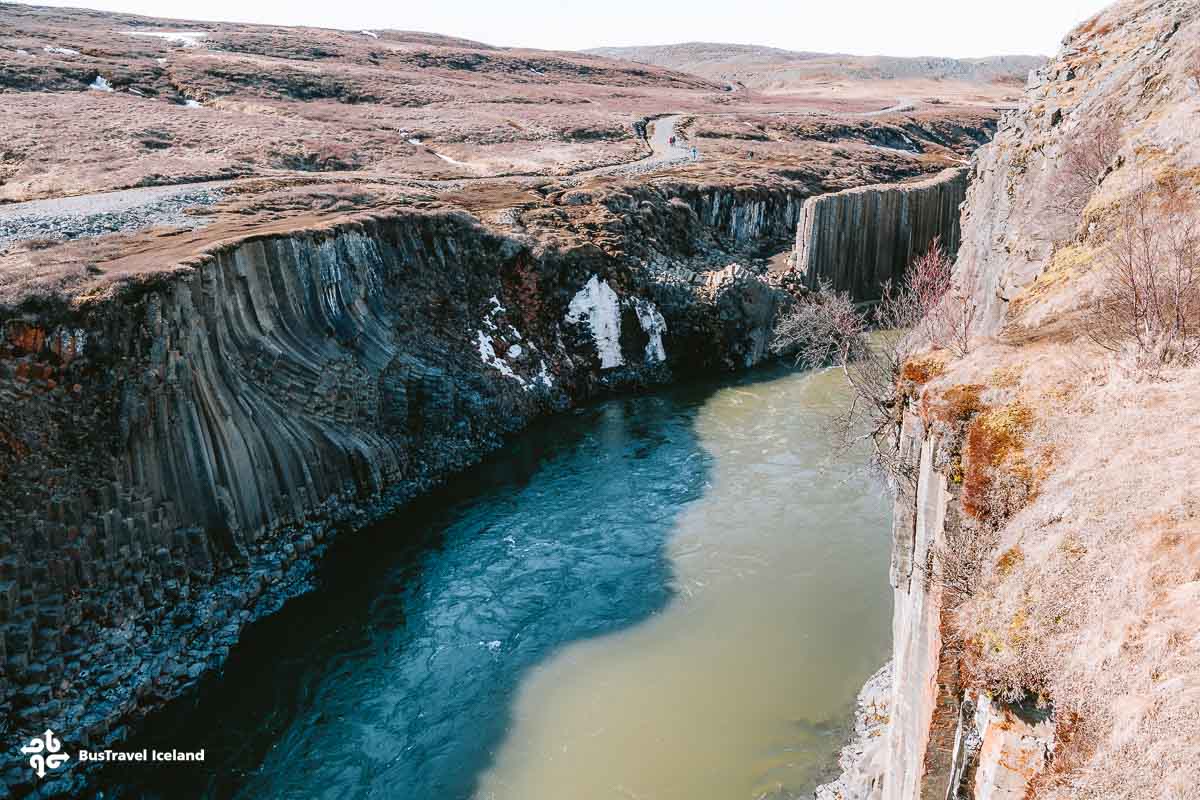
East Side of the Canyon: A Scenic Hike to the Iconic Viewpoint
For a more adventurous experience, the east side begins near Skjödólfsstaðir farm, also along Route 923. From here, visitors embark on a 5-6 kilometer (round-trip) hike that runs along the riverbank, offering a more panoramic view of the canyon.
While this side does not provide direct river access, it features the most famous Instagram-worthy view—where the towering basalt cliffs rise dramatically from the glacial river, creating an awe-inspiring scene of Iceland’s raw natural beauty. This side is ideal for those seeking a quieter, immersive journey into the rugged landscapes of the Jökuldalur Valley.

When traveling on Road 923 in Efri Jökuldalur, be prepared for a narrow, winding gravel road with numerous twists, curves, and hills that can limit visibility. This scenic route passes through active farmland, so it’s common to encounter sheep on the road, as well as wild birds and reindeer in the valley. Additionally, expect to share the road with tractors, grain trucks, cyclists, and other slow-moving vehicles. While the road is narrow, it still accommodates two-way traffic, though there is no center line to guide drivers. Extra caution is advised, especially in low-visibility conditions.

Guided Tours to Studlagil Canyon
Many day tours from Seyðisfjörður include a visit to the west side, while Ring Road tours increasingly feature Stuðlagil Canyon as one of the highlights in East Iceland. Whether you choose the easy access of the east side or the iconic, photo-worthy views from the west, Stuðlagil Canyon promises an unforgettable experience, showcasing Iceland’s extraordinary geological wonders and off-the-beaten-path beauty.
How Long is the Studlagil Canyon Hike
For those drawn to Iceland’s untamed landscapes, Stuðlagil Canyon offers more than just a quick roadside attraction. While many visitors settle for the easily accessible west-side viewing platform, the real adventure lies in hiking deep into the canyon itself—a journey that unveils its full grandeur, far from the crowds.
The best way to explore Stuðlagil Canyon up close is by taking the east-side hiking trail. The hike begins near Skjödólfsstaðir farm, located off Route 923, where a parking lot marks the starting point of the trail. From here, hikers follow a winding dirt road that hugs the river, offering panoramic views of the canyon’s basalt formations as they descend toward the water’s edge.
The Stuðlagil Canyon hike varies in length from approximately 2 to 3.5 miles (one way), depending on how deep into the canyon you choose to explore. On average, the hike takes 30 minutes to over an hour one way, with factors like pace and fitness level influencing the duration.
The trail consists of stones, rocks, dirt paths, marshy patches, and slippery surfaces, making sturdy hiking boots essential. With an elevation gain of around 500 feet, hikers will encounter two to three moderate inclines along the way. The hike is generally considered easy to moderate, though those venturing down into the canyon from the east side should exercise caution, as the rocks can be extremely slippery.
The best time to hike is between May and September, when the weather is milder, and the Jökla River’s turquoise hues are at their most vibrant. To reach the east side car park, use Google Maps to search for “Stuðlagil (Bridge parking)” or enter the GPS coordinates (N 65.1879375, W -15.2854315) for easy navigation. Whether you’re looking for a quick scenic walk or a longer immersive trek, Studlagil Canyon offers an unforgettable adventure through one of Iceland’s most striking landscapes.
About halfway through the journey, hikers encounter Stuðlafoss, a stunning waterfall cascading over basalt columns. This lesser-known basalt column waterfall, often overshadowed by the canyon itself, is a beautiful midpoint stop—a perfect place for a break, photos, and a moment of tranquility before continuing the trek deeper into the valley.
Unlike the west-side viewpoint, which provides a quick but somewhat distant glimpse of the canyon, the east-side hike immerses visitors in the landscape itself. The journey takes about 1.5 to 2 hours, depending on pace and weather conditions, with modest elevation changes and uneven terrain. Iceland’s notorious weather shifts quickly, so sturdy hiking boots and waterproof gear are highly recommended.
The reward? A rare, up-close encounter with one of Iceland’s most striking geological formations. As hikers reach the lower canyon, the full scale of the towering basalt walls becomes evident. The vibrant turquoise waters of the Jökla River, which shift in hue depending on the season, weave through the canyon, creating a scene that feels almost otherworldly.
For those willing to venture even further, the trail extends deeper into the valley, where hidden vantage points offer lesser-seen perspectives of the canyon. Unlike the more structured trails of Iceland’s famous tourist spots, this is raw, unspoiled terrain, rewarding those who seek solitude and discovery.
Hiking Stuðlagil Canyon in its entirety isn’t just about reaching a viewpoint—it’s about experiencing one of Iceland’s last great secrets the way it was meant to be explored: on foot, away from the crowds, in the heart of its breathtaking wilderness.
The Best Time to Visit Studlagil Canyon
Travelers planning to visit Stuðlagil Canyon should check weather conditions and trail accessibility before setting out, as seasonal changes significantly impact access to the area.
At Grund, a staircase and viewing platform provide a safe and accessible year-round vantage point of the canyon’s iconic basalt formations. However, visitors should note that Road 923, the primary route to the site, receives limited winter maintenance. Before making the trip, it is essential to check road conditions, as snow and ice can make travel hazardous.
For those wishing to hike down into the canyon, understanding the trail conditions is crucial. The hiking path begins at the bridge near Hákonarstaðir, stretching approximately 5 kilometers one way (10 km round trip). To reach the trailhead, visitors must take the turn marked “Klaustursel” farm and drive 500 meters to the parking lot near the bridge.
Generally, the hiking trail is accessible from mid-June to October, offering a safe and scenic route into the canyon. However, during winter months, the path becomes treacherous due to ice and snow, particularly near the canyon’s edges. In spring, side rivers that intersect the trail swell with meltwater, making crossings unsafe. Additionally, hikers should exercise extreme caution as snow covering the river may collapse underfoot.
Visitors are strongly advised to assess conditions in advance, wear sturdy hiking gear, and avoid attempting the trek in unsafe weather. Proper preparation ensures a safe and rewarding experience in one of Iceland’s most breathtaking landscapes.
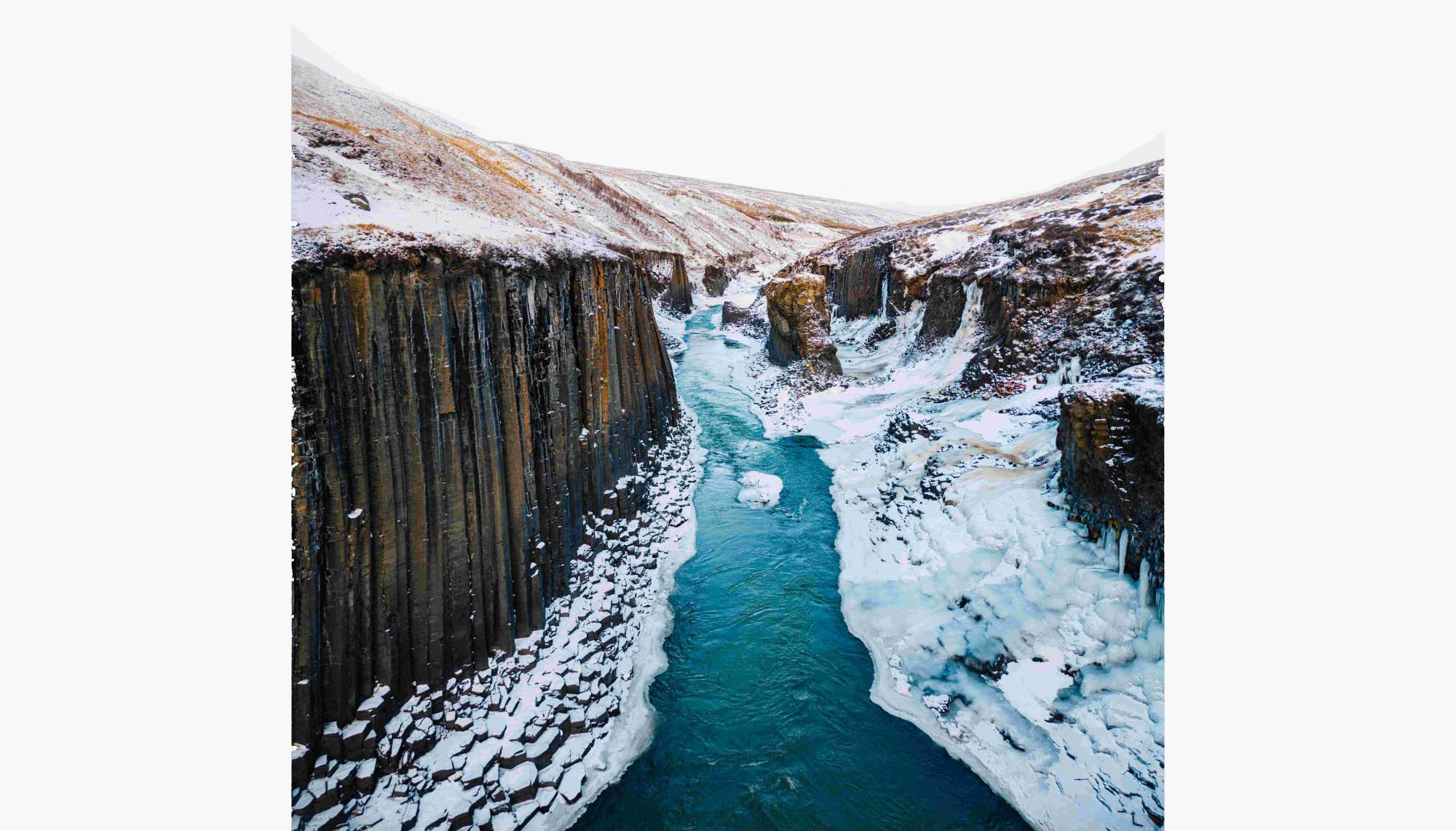
What’s So Special About Studlagil Canyon
Found in the remote highlands of East Iceland, Stuðlagil Canyon is quickly becoming one of the country’s most captivating attractions. What was once submerged beneath a raging glacial river has, in recent years, emerged as a geological marvel—one that showcases Iceland’s untamed beauty in its purest form.
The canyon’s defining feature is its towering basalt columns, perfectly hexagonal formations sculpted by ancient volcanic activity. These formations, reminiscent of the famous Giant’s Causeway in Northern Ireland, rise dramatically from the riverbanks, creating a surreal contrast against the striking turquoise waters that now flow through the canyon.
For centuries, this spectacle remained hidden beneath the Jökla River, a powerful glacial current that carved its way through the Jökuldalur Valley. The river’s volume, however, changed dramatically with the construction of the Kárahnjúkar Hydroelectric Plant in the early 2000s. As the water level receded, the canyon was revealed—its basalt walls exposed for the first time, drawing the attention of geologists, photographers, and adventurous travelers alike.
Unlike Iceland’s more famous waterfalls and volcanoes, Stuðlagil Canyon remains a local secret—at least for now. Its remote location, roughly a five-hour drive from Reykjavík, means it doesn’t attract the same overwhelming crowds as the Golden Circle or the Blue Lagoon. Yet, those who make the journey are rewarded with one of the most visually arresting landscapes in Iceland—a canyon so uniquely sculpted that it feels almost otherworldly.
There’s something undeniably cinematic about the scene: the stillness of the river, the rhythmic geometry of the basalt walls, the quiet vastness of the surrounding valley. It is a place where nature’s forces—fire, water, and ice—have come together in a display that feels both ancient and ever-changing.
For those willing to explore beyond Iceland’s well-worn tourist trails, Stuðlagil Canyon offers a rare opportunity—a glimpse into the raw, unspoiled beauty that has long defined this island nation. And with its growing reputation as a must-see destination, it may not stay a secret for much longer.
